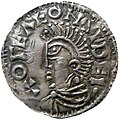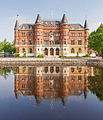Welcome to the Sweden Portal! | |||||||||

|

|

| |
Sweden, formally the Kingdom of Sweden, is a Nordic country located on the Scandinavian Peninsula in Northern Europe. It borders Norway to the west and north, Finland to the east, and is connected to Denmark in the southwest by a bridge–tunnel across the Öresund.
At 450,295 square kilometres (173,860 sq mi), Sweden is the largest Nordic country and the fifth-largest country in Europe. The capital and largest city is Stockholm. Sweden has a population of 10.5 million, and a low population density of 25.5 inhabitants per square kilometre (66/sq mi), with around 87% of Swedes residing in urban areas, which cover 1.5% of the entire land area, in the central and southern half of the country. Nature in Sweden is dominated by forests and many lakes, including some of the largest in Europe. Many long rivers run from the Scandes range, primarily emptying into the northern tributaries of the Baltic Sea. It has an extensive coastline and most of the population lives near a major body of water. With the country ranging from 55°N to 69°N, the climate of Sweden is diverse due to the length of the country.
Germanic peoples have inhabited Sweden since prehistoric times, emerging into history as the Geats (Swedish: Götar) and Swedes (Svear) and constituting the sea peoples known as the Norsemen. A unified Swedish state emerged during the early 11th century. After the Black Death in the middle of the 14th century killed about a third of the Scandinavian population, the dominance of the Hanseatic League in Northern Europe threatened Scandinavia economically and politically. This led to the formation of the Scandinavian Kalmar Union in 1397, which Sweden left in 1523. When Sweden became involved in the Thirty Years' War on the Protestant side, an expansion of its territories began, forming the Swedish Empire, which remained one of the great powers of Europe until the early 18th century. (Full article...)
Swedish heraldry encompasses heraldic achievements in modern and historic Sweden. Swedish heraldic style is consistent with the German-Nordic heraldic tradition, noted for its multiple helmets and crests which are treated as inseparable from the shield, its repetition of colours and charges between the shield and the crest, and its scant use of heraldic furs. Because the medieval history of the Nordic countries was so closely related, their heraldic individuality developed rather late. Swedish and Finnish heraldry have a shared history prior to the Diet of Porvoo in 1809; these, together with Danish heraldry, were heavily influenced by German heraldry. Unlike the highly stylized and macaronic language of English blazon, Swedish heraldry is described in plain language, using (in most cases) only Swedish terminology.
The earliest known achievements of arms in Sweden are those of two brothers, Sigtrygg and Lars Bengtsson, from 1219. The earliest example of Swedish civic heraldry is the city arms of Kalmar, which originated as a city seal in 1247. The seal (Swedish sigill), used extensively in the Middle Ages, was instrumental in spreading heraldry to churches, local governments, and other institutions, and was the forerunner of the coat of arms in medieval Sweden. Armorial seals of noblewomen appeared in the 12th century, burghers and artisans began adopting arms in the 13th century, and even some peasants took arms in the 14th century. (Full article...)Selected article -

Swedish Pomerania (Swedish: Svenska Pommern; German: Schwedisch-Pommern) was a dominion under the Swedish Crown from 1630 to 1815 on what is now the Baltic coast of Germany and Poland. Following the Polish War and the Thirty Years' War, Sweden held extensive control over the lands on the southern Baltic coast, including Pomerania and parts of Livonia and Prussia (dominium maris baltici).
Sweden, which had been present in Pomerania with a garrison at Stralsund since 1628, gained effective control of the Duchy of Pomerania with the Treaty of Stettin in 1630. At the Peace of Westphalia in 1648 and the Treaty of Stettin in 1653, Sweden received Western Pomerania (German Vorpommern), with the islands of Rügen, Usedom, and Wolin, and a strip of Farther Pomerania (Hinterpommern). The peace treaties were negotiated while the Swedish queen Christina was a minor, and the Swedish Empire was governed by members of the high aristocracy. As a consequence, Pomerania was not annexed to Sweden like the French war gains, which would have meant abolition of serfdom, since the Pomeranian peasant laws of 1616 was practised there in its most severe form. Instead, it remained part of the Holy Roman Empire, making the Swedish rulers Reichsfürsten (imperial princes) and leaving the nobility in full charge of the rural areas and its inhabitants. While the Swedish Pomeranian nobles were subjected to reduction when the late 17th-century kings regained political power, the provisions of the peace of Westphalia continued to prevent the pursuit of the uniformity policy in Pomerania until the Holy Roman Empire was dissolved in 1806. (Full article...)Did you know -

- ...that the Oresund Bridge connecting Sweden and Denmark is the longest combined road and rail bridge in Europe?
- ...that Birger Dahlerus was a Swedish businessman and friend of Hermann Göring, who made numerous trips between Germany and England in 1939 in an attempt to avert the Second World War?
- ... that "Baggböleri", the Swedish derogatory term for deforestation, is named after Baggböle on the Ume River?
General images -
The Battle of Öland was a naval battle between an allied Danish-Dutch fleet and the Swedish navy in the Baltic Sea, off the east coast of Öland on 1 June 1676. The battle was a part of the Scanian War (1675–79) fought for supremacy over the southern Baltic. Sweden was in urgent need of reinforcements for its north German possessions; Denmark sought to ferry an army to Scania in southern Sweden to open a front on Swedish soil.
Just as the battle began, the Swedish flagship Kronan sank, taking with it almost the entire crew, including the Admiral of the Realm and commander of the Swedish navy, Lorentz Creutz. The allied force under the leadership of the Dutch admiral Cornelis Tromp took full advantage of the ensuing disorder on the Swedish side. The acting commander after Creutz's sudden demise, Admiral Claes Uggla, was surrounded and his flagship Svärdet battered in a drawn-out artillery duel, then set ablaze by a fire ship. Uggla drowned while escaping the burning ship, and with the loss of a second supreme commander, the rest of the Swedish fleet fled in disorder. (Full article...)Categories
Main topics
Subdivisions: Counties of Sweden • Municipalities of Sweden • Provinces of Sweden

History: 1975 Occupation of the West German embassy • Ådalen shootings • Consolidation of Sweden • Early Swedish history • Enlightened Absolute Monarchy in Sweden • Early Vasa era • Industrialization of Sweden • Post-war Sweden • Prehistoric Sweden • Rise of Sweden as a Great Power • Suiones • Swedish Empire • Sweden after the Great Northern War • Sweden and the Winter War • Sweden during late 19th century • Sweden during World War II • Swedish allotment system • Swedish emigration to the United States • Union between Sweden and Norway
Politics: Alliance for Sweden • Constitution of Sweden • Foreign relations of Sweden • Government of Sweden • Parliament of Sweden • Riksdag • Swedish general election, 2006 • Swedish general election, 2010 • Swedish neutrality • Swedish welfare
Demographics: Education • Ethnic minorities • Languages • Religion • Subdivisions • Cities • People • Healthcare • Immigration
Culture: Cinema of Sweden • Cuisine of Sweden • Music of Sweden • Sports in Sweden • Swedish literature • Tourism in Sweden
Symbols: Flag • Coat of arms • National anthem
Things you can do
 |
Here are some tasks awaiting attention:
|
Wikipedia in Swedish
 |
There is a Swedish version of Wikipedia, the free encyclopedia. |
 |
WikiProjects
Featured and good content
Related portals
Northern Europe
Other countries









































